Galaxy 2024 Q4 Crypto Venture Capital Report: Bitcoin hit all-time highs, but VC investment fell short of the same period

Reprinted from panewslab
01/17/2025·16days agoAuthor: Alex Thorn, Gabe Parker, Galaxy
Compiled by: Luffy, Foresight News
introduction
2024 is a landmark year for the cryptocurrency market. The spot Bitcoin exchange-traded open-end index fund (ETP) was launched at the beginning of the year. In November, the United States welcomed the most supportive president and Congress in history for cryptocurrency, marking a successful end to the year. period. In 2024, the total market value of the cryptocurrency circulation market increased by US$1.6 trillion, a year-on-year increase of 88%, reaching US$3.4 trillion at the end of the year. The market value of Bitcoin alone increased by US$1 trillion and was close to US$2 trillion by the end of the year. The development trend of the cryptocurrency market in 2024 will be driven by the rapid rise of Bitcoin on the one hand, and the influence of Memecoin and artificial intelligence-related cryptocurrencies on the other. For much of the year, Memecoin was popular, with most on-chain activity occurring on the Solana blockchain. In the second half of the year, artificial intelligence agents (AI agents) cryptocurrencies became a new focus.
In 2024, venture capital (VC) in the cryptocurrency field will still be difficult. Mainstream hot topics such as Bitcoin, Memecoin, and AI agents are not suitable for venture capital investment. Memecoin can be launched with just a few clicks of a button, and Memecoin and AI agent-related cryptocurrencies run almost entirely on-chain, leveraging existing infrastructure primitives. Hot areas in the last market cycle, such as decentralized finance (DeFi), gaming, the Metaverse and non-fungible tokens (NFT), either failed to attract a lot of market attention or have been completed and require less funds , new start-ups face more intense competition. Businesses related to cryptocurrency market infrastructure are mostly already established and in advanced stages of development, and with expected regulatory changes under the next U.S. administration, these areas may face competition from traditional financial services intermediaries. There are signs that some new hot spots are emerging and may become an important driving force for new capital inflows, but most of them are not yet mature or even in their infancy: the more prominent ones include stablecoins, tokenization, DeFi and traditional finance (TradFi ), and the intersection of cryptocurrency and AI.
Macroeconomic and broader market forces also pose headwinds. The high interest rate environment continues to put pressure on the venture capital industry, with capital allocators less willing to take on higher risks. This phenomenon has squeezed the entire venture capital industry, and the cryptocurrency venture capital field may be more severely affected due to its higher risk perception. Meanwhile, large integrated venture capital firms have mostly remained shy of the space, perhaps still wary of the collapse of several high-profile venture-backed companies in 2022.
So while there are significant opportunities ahead, whether through the resurgence of existing primitives and narratives or the emergence of something new, crypto venture capital remains competitive and relatively tame compared to the frenzy of 2021 and 2022. The number of deals and investment dollars have increased, but the number of new funds has stagnated and less money has been allocated to venture capital funds, creating a particularly competitive environment that favors founders in valuation negotiations. Overall, venture capital investment remains well below levels seen in the last market cycle.
However, the increasing institutionalization of Bitcoin and digital assets, the growth of stablecoins, and the new regulatory environment that may ultimately lead to the convergence of DeFi and TradFi point to new opportunities for innovation. We expect that 2025 could see a significant pickup in venture capital activity and attention.
Summary of key points
- In the fourth quarter of 2024, venture capital investment in cryptocurrency startups was US$3.5 billion (up 46% quarter-on-quarter), involving 416 transactions (down 13% quarter-on-quarter).
- Throughout 2024, venture capital institutions invested US$11.5 billion in cryptocurrency and blockchain startups, with a total of 2,153 transactions.
- Early-stage deals attracted the most capital investment (60%), while late-stage deals accounted for 40% of invested capital, a significant increase from 15% in the third quarter.
- Median valuations for venture capital deals rose in the second and third quarters, with valuations for cryptocurrency deals growing faster than the overall venture capital industry, but were flat sequentially in the fourth quarter.
- Stablecoin companies have raised the most funds, with Tether raising $600 million from Cantor Fitzgerald, followed by infrastructure and Web3 startups. Web3, DeFi and infrastructure companies had the highest number of deals.
- In the fourth quarter of 2024, startups headquartered in the United States received the most investment funds (46%), with Hong Kong companies’ investment share rising to 17%. In terms of transaction volume, the United States accounts for 36%, ranking first, followed by Singapore (9%) and the United Kingdom (8%).
- On the fundraising front, capital allocators’ interest in cryptocurrency-focused venture capital funds fell to $1 billion across 20 new funds.
- At least 10 cryptocurrency venture capital funds will raise more than $100 million in 2024.
Venture capital situation
Transaction quantity and investment amount
In the fourth quarter of 2024, venture capitalists invested $3.5 billion in startups focusing on cryptocurrency and blockchain (up 46% quarter-on-quarter), with a total of 416 transactions (down 13% quarter-on-quarter).
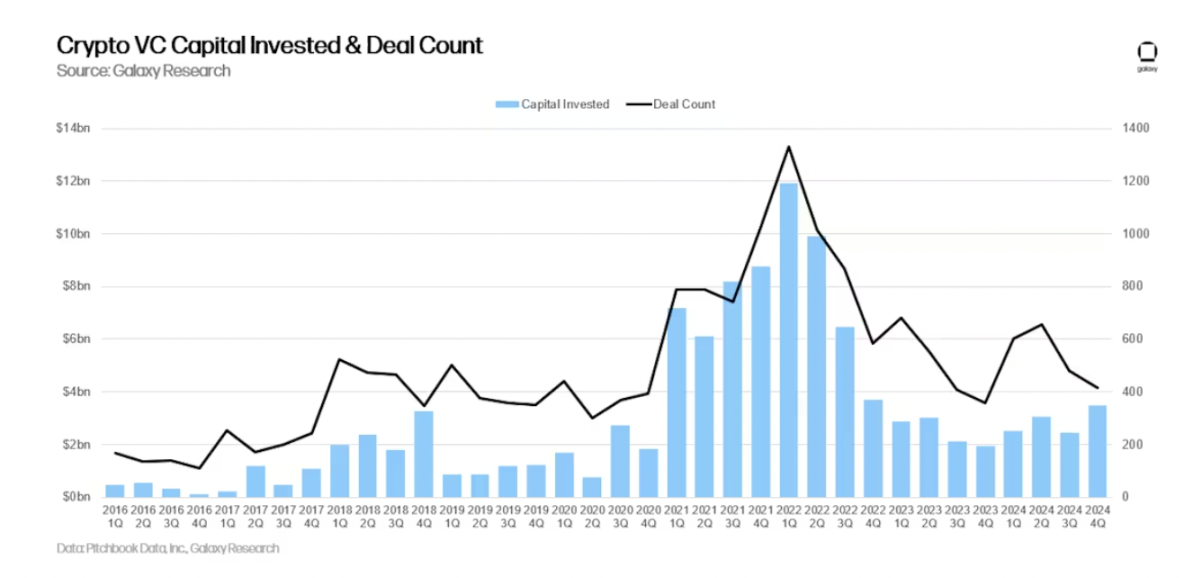
Throughout 2024, venture capitalists invested US$11.5 billion in cryptocurrency and blockchain startups, with a total of 2,153 transactions.
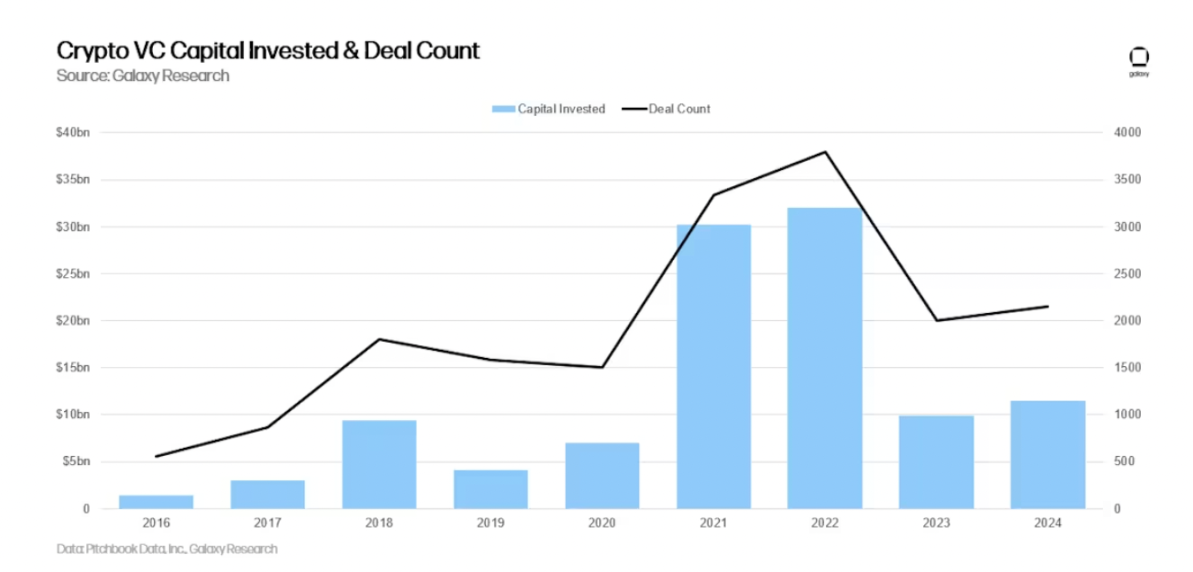
Investment Amount and Bitcoin Price
Over the past few cycles, there has been a long-term correlation between the price of Bitcoin and the amount of investment in cryptocurrency startups, but over the past year, this correlation has not been clear. Bitcoin prices have surged since January 2023, while venture capital activity has not kept pace. The divergence is partially explained by capital allocators' waning interest in crypto ventures, as well as in venture capital overall, coupled with the crypto market's preference for a Bitcoin narrative that ignores many of the hot narratives of 2021.
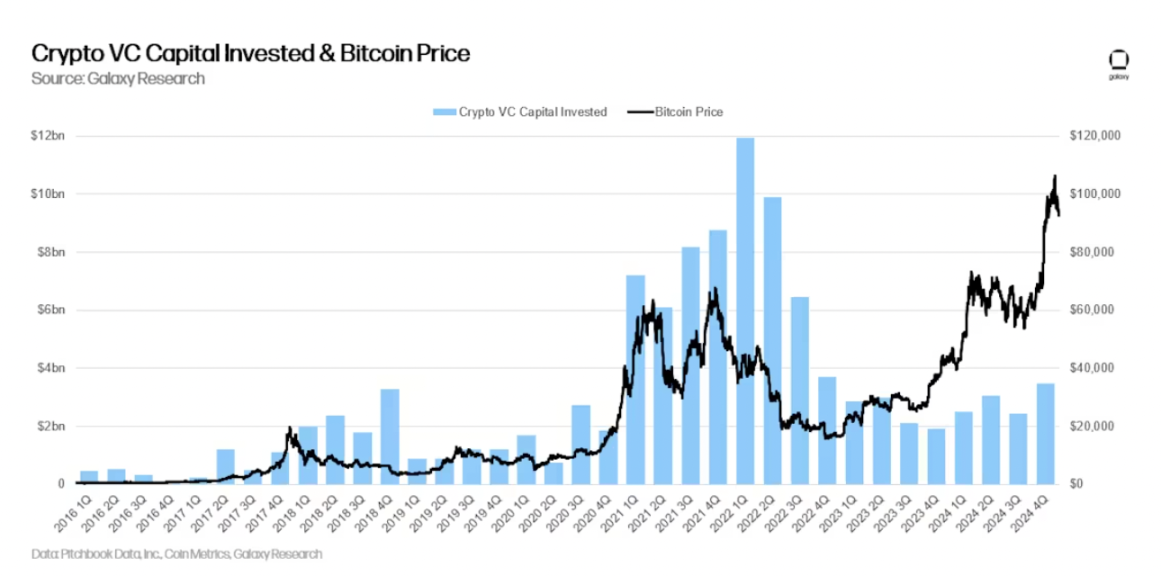
Investment by stage
In the fourth quarter of 2024, 60% of venture capital investment was in early-stage companies and 40% in later-stage companies. Venture capital firms have raised new capital in 2024, and funds focused on the cryptocurrency space may still have available capital left over from large fundraisings a few years ago. Since the third quarter, the proportion of funding received by late-stage companies has increased, which can be attributed in part to the reported $600 million in financing Tether received from Cantor Fitzgerald.
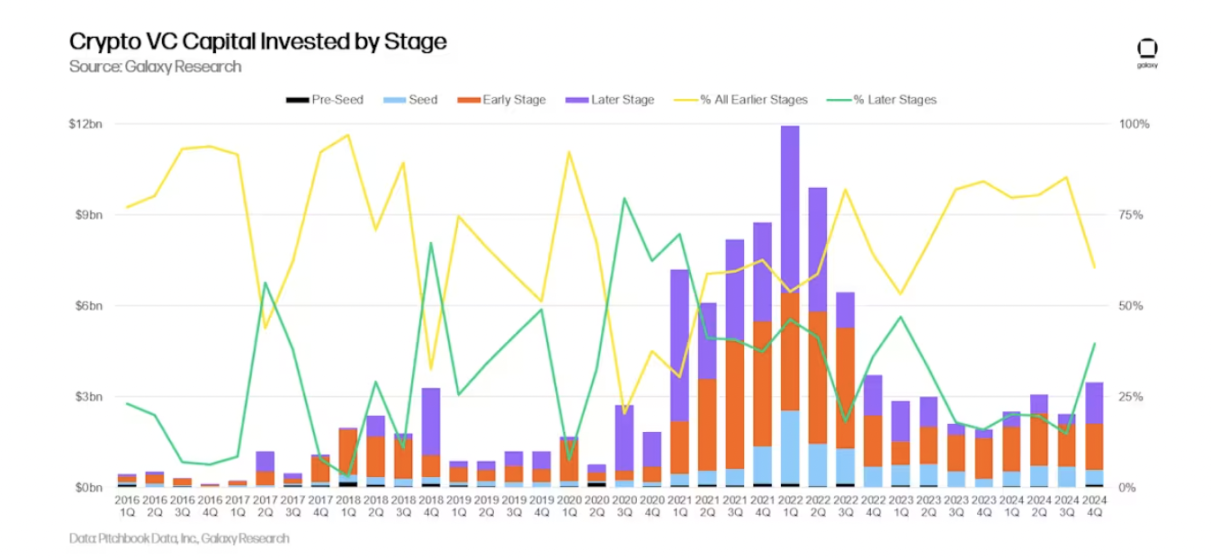
The proportion of pre-seed deals has increased slightly and remains in good shape compared to previous cycles. We measure entrepreneurial activity by tracking the proportion of pre-seed deals.
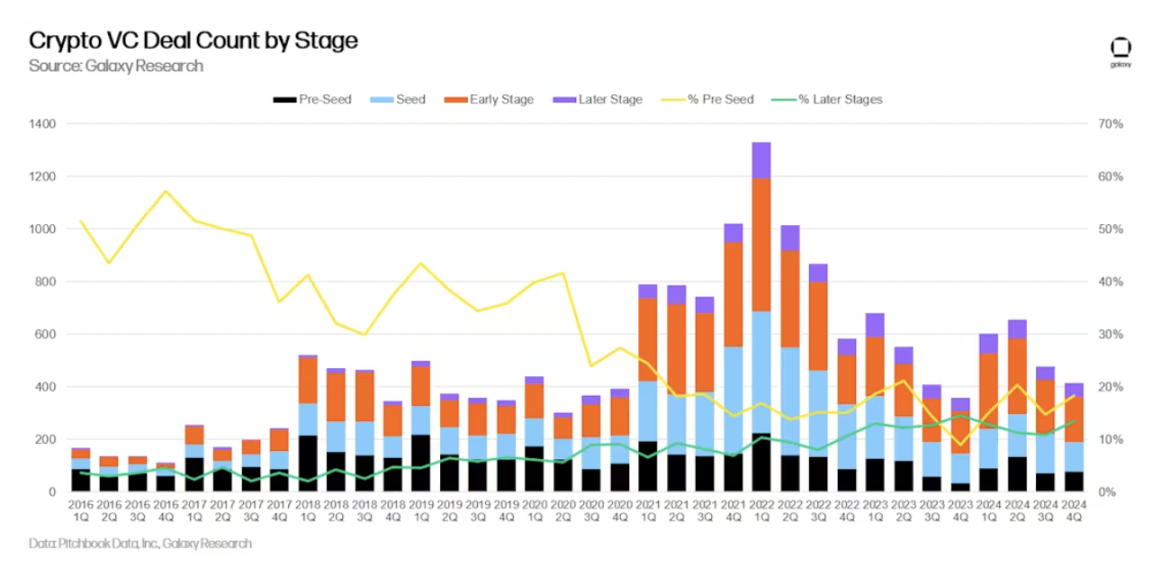
Valuation and deal size
Venture capital-backed cryptocurrency company valuations fell significantly in 2023, falling to their lowest levels since Q4 2020 in the fourth quarter of 2023. However, as Bitcoin hit all-time highs in the second quarter of 2024, valuations and deal sizes began to rebound. In the second and third quarters of 2024, valuations reached their highest levels since 2022. The rise in cryptocurrency deal sizes and valuations in 2024 is in line with a similar upward trend in the overall venture capital space, although the rebound in the cryptocurrency space has been stronger. The median pre-money valuation of deals in Q4 2024 was $24 million, with the average deal size being $4.5 million.
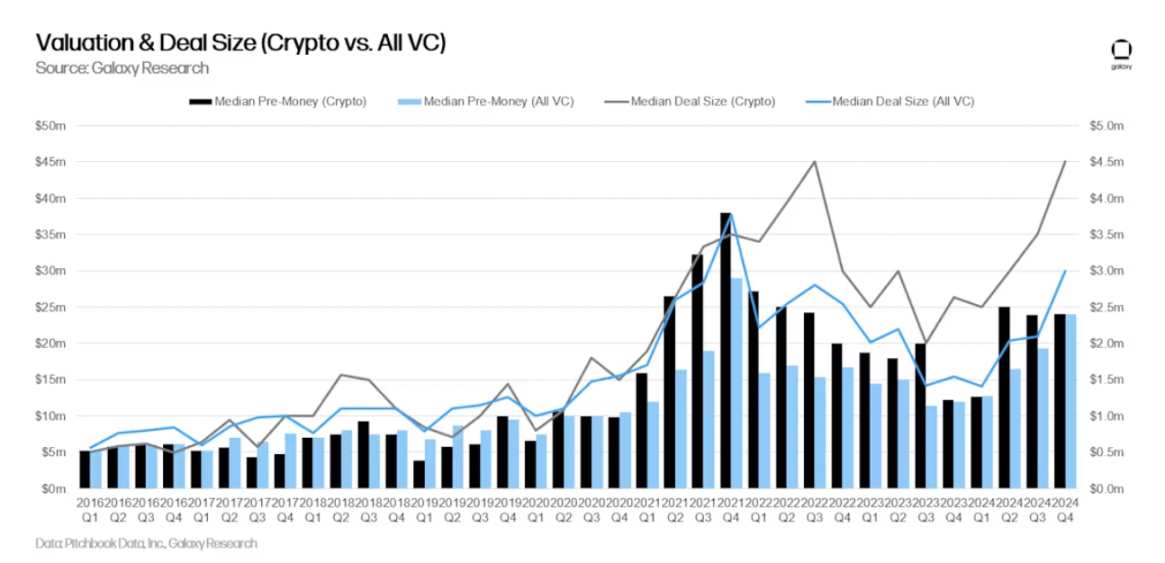
Investments by Category
In the fourth quarter of 2024, companies and projects in the "Web3/NFT/DAO/Metaverse/Game" category received the largest share of venture capital funds (20.75%), totaling US$771.3 million. The three largest deals in this category were Praxis, Azra Games, and Lens, which raised $525 million, $42.7 million, and $31 million, respectively. DeFi's dominance of total cryptocurrency venture capital investment is due to Tether's $600 million deal with Cantor Fitzgerald, which took a 5% stake in the company (stablecoin issuers fall into our broad DeFi category). Although this deal was not a traditional venture capital structured transaction, we included it in our statistics. If the Tether transaction is excluded, the DeFi category will drop to seventh place in terms of investment amount in the fourth quarter.
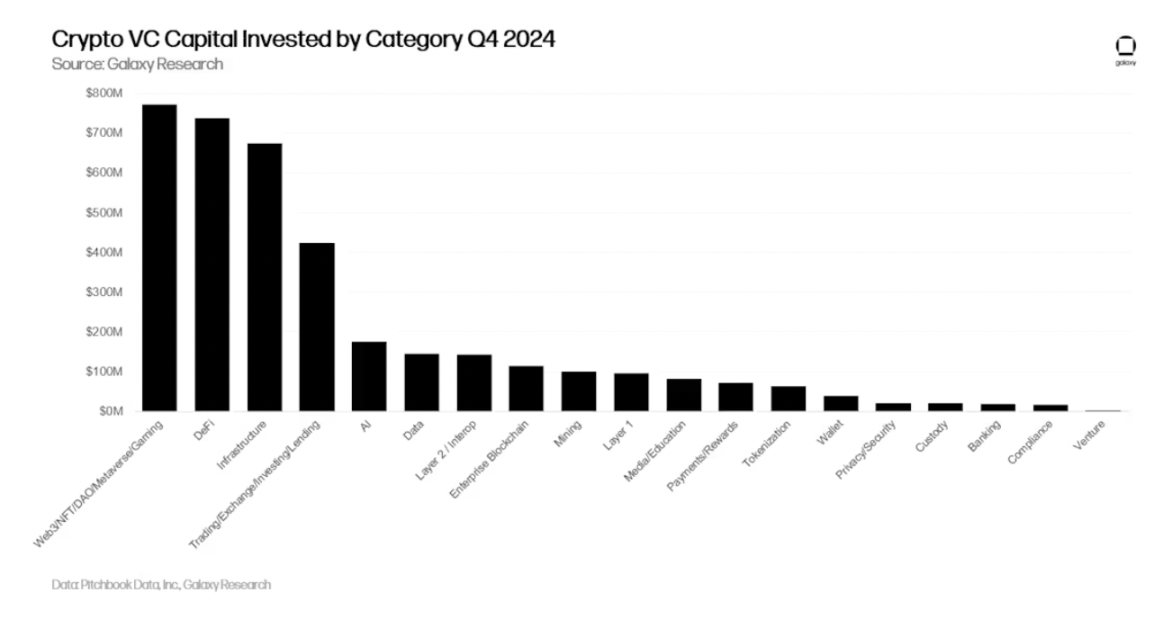
In the fourth quarter of 2024, cryptocurrency startups building Web3/NFT/DAO/Metaverse and infrastructure products accounted for a quarterly increase of 44.3% and 33.5% in total quarterly cryptocurrency venture capital investment respectively. The increase in capital allocation as a proportion of total deployed capital was primarily due to a significant quarter-on-quarter decline in capital allocation to Layer 1 and crypto-AI startups, down 85% and 55% respectively since the third quarter of 2024.
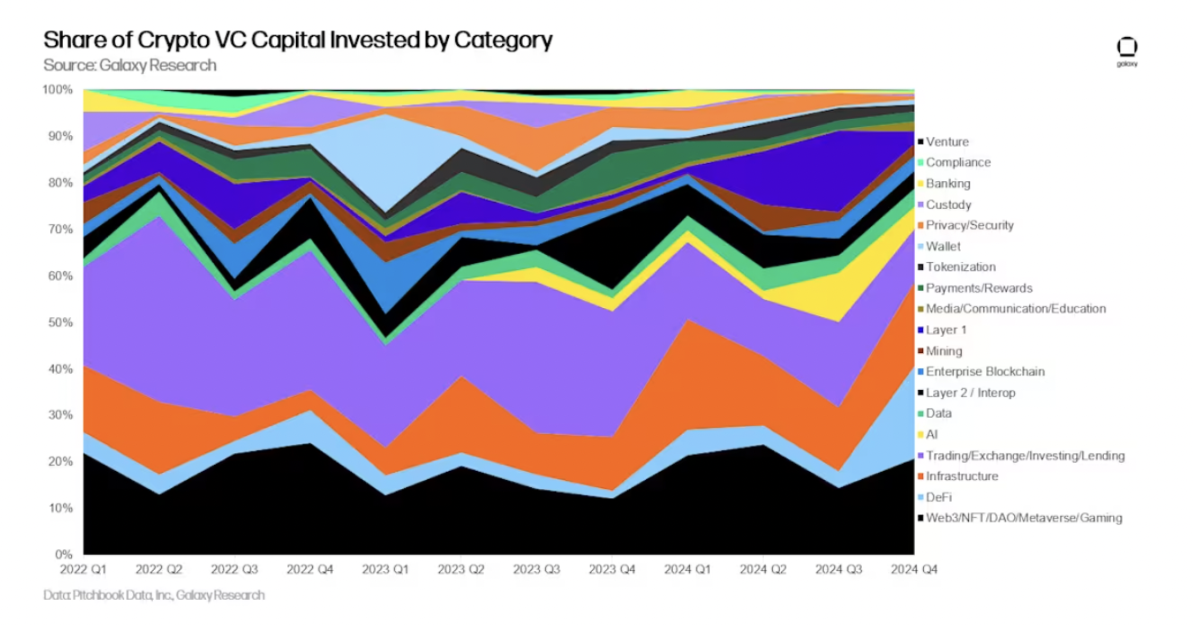
If the above larger categories are further broken down, cryptocurrency projects building stablecoins received the largest share of investment in the fourth quarter of 2024 (17.5%), raising a total of $649 million across the 9 transactions tracked. However, Tether's $600 million deal accounted for the majority of total investment in stablecoin companies in the fourth quarter of 2024. Cryptocurrency startups developing infrastructure received the second-highest amount of venture capital funding in the fourth quarter of 2024, raising a total of $592 million across 53 deals tracked. The three largest crypto infrastructure transactions are Blockstream, Hengfeng Company and Cassava Network, with financing amounts of US$210 million, US$100 million and US$90 million respectively. Following crypto infrastructure, Web3 startups and exchanges ranked third and fourth in terms of funding received from cryptocurrency venture capital institutions, totaling $587.6 million and $200 million respectively. It is worth noting that Praxis was the largest Web3 deal in the fourth quarter of 2024 and the second largest overall deal, raising up to $525 million to create an "Internet native city."
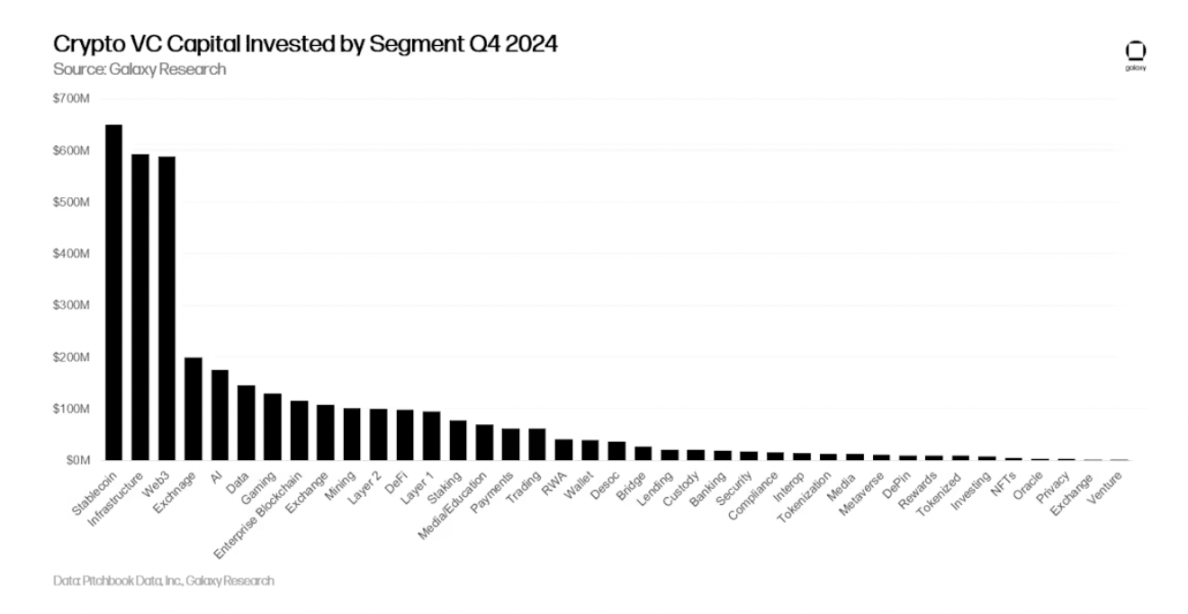
In terms of the number of transactions, the Web3/NFT/DAO/Metaverse/Game category leads with 22% of transactions (92 transactions), including 37 game transactions and 31 Web3 transactions. In the fourth quarter of 2024, there were 77 and 43 transactions in the Infrastructure and Trading/Exchange/Investment/Lending categories respectively.
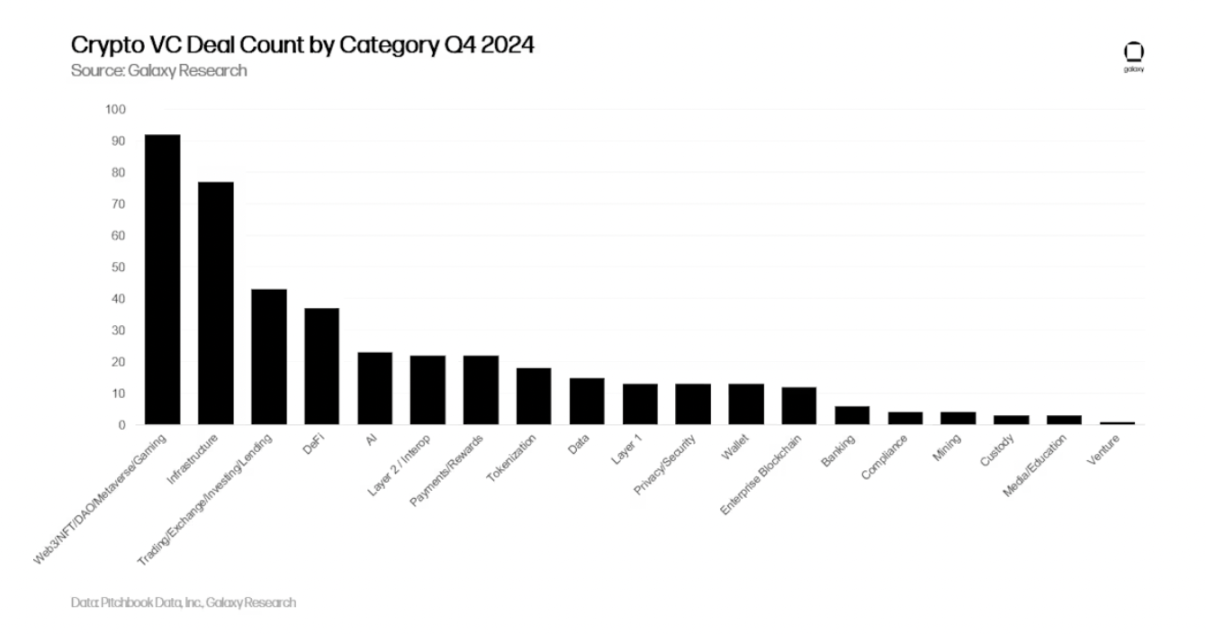
Projects and companies providing crypto infrastructure ranked second in the number of transactions, accounting for 18.3% of the total number of transactions (77 transactions), an increase of 11% month-on-month. After crypto infrastructure, projects and companies building trading/exchange/investment/lending products ranked third in terms of number of transactions, accounting for 10.2% of the total number of transactions (43 transactions). Notably, cryptocurrency companies building wallets and payment/reward products saw the largest month-on-month increase in the number of transactions, reaching 111% and 78% respectively. Despite significant sequential percentage increases, wallet and payments/rewards startups were involved in only 22 and 13 transactions respectively in Q4 2024.
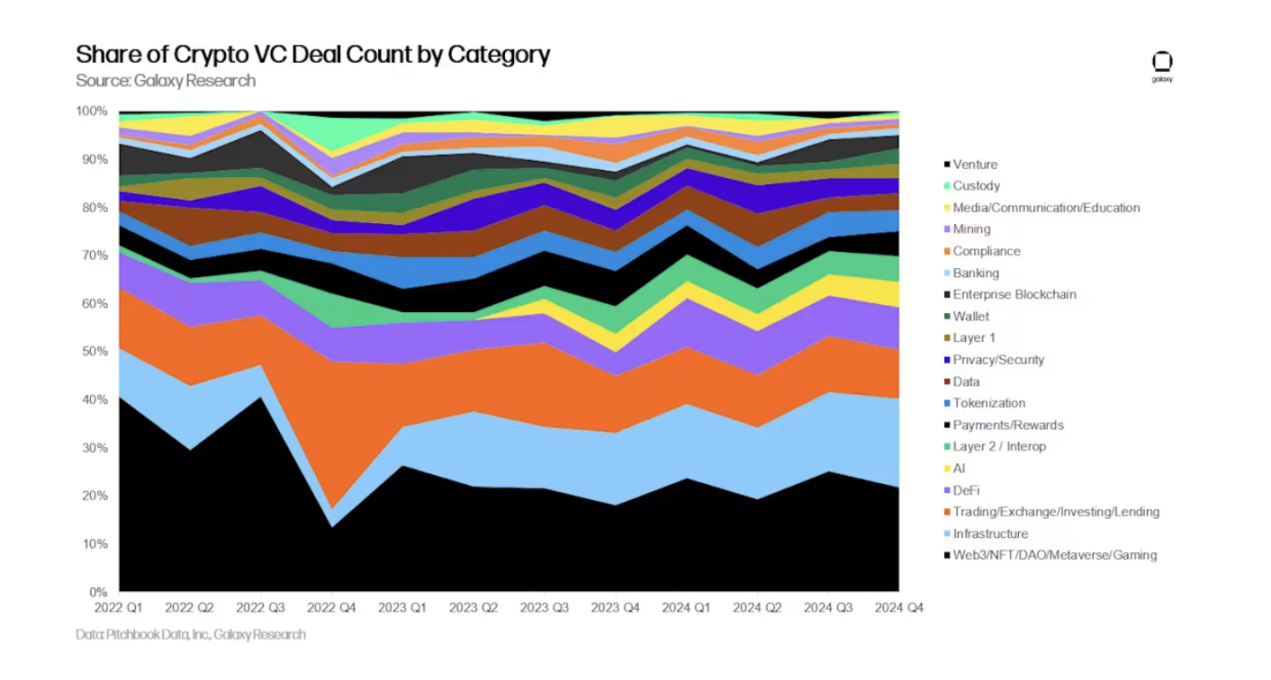
Breaking down the larger categories above, projects and companies building crypto infrastructure had the highest number of deals (53) of all segments. Gaming and Web3-related cryptocurrency companies followed, completing 37 and 31 transactions respectively in the fourth quarter of 2024, almost the same ranking as in the third quarter of 2024.
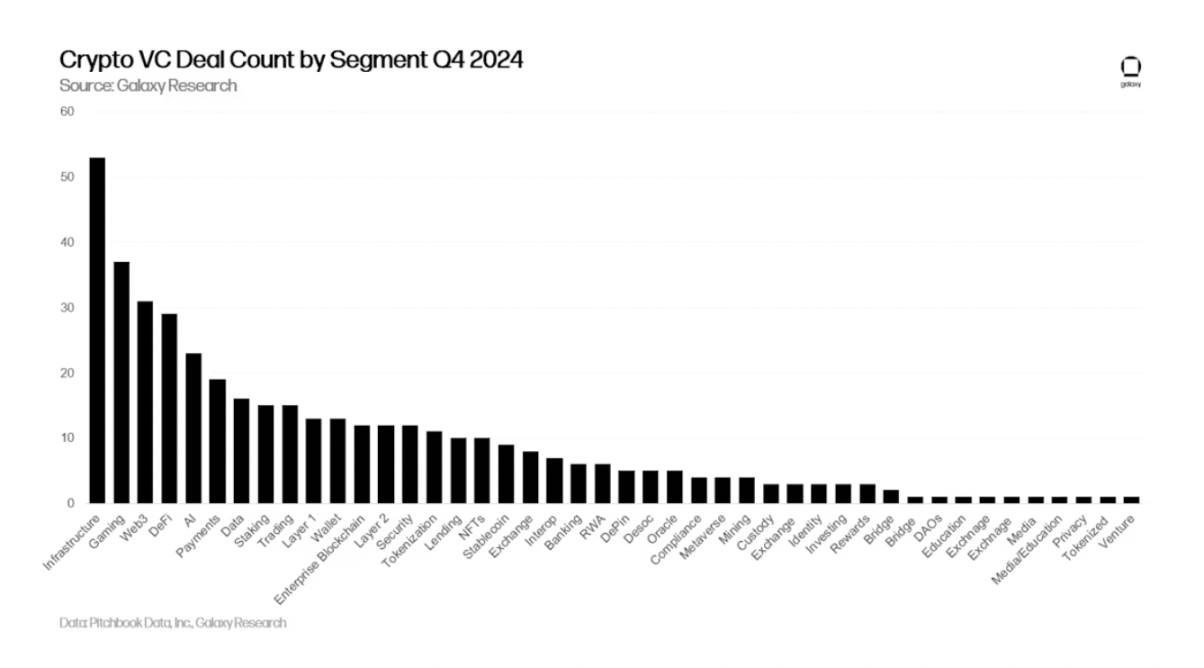
Investments by stage and category
Breaking down investment dollars and deal numbers by category and stage provides a clearer picture of what types of companies in each category are raising capital. In the fourth quarter of 2024, most of the funds in the Web3/DAO/NFT/Metaverse, Layer 2, and Layer 1 fields have flowed to early-stage companies and projects. In contrast, a large portion of cryptocurrency venture capital funds invested in DeFi, trading/exchange/investing/lending, and mining has gone to later-stage companies.
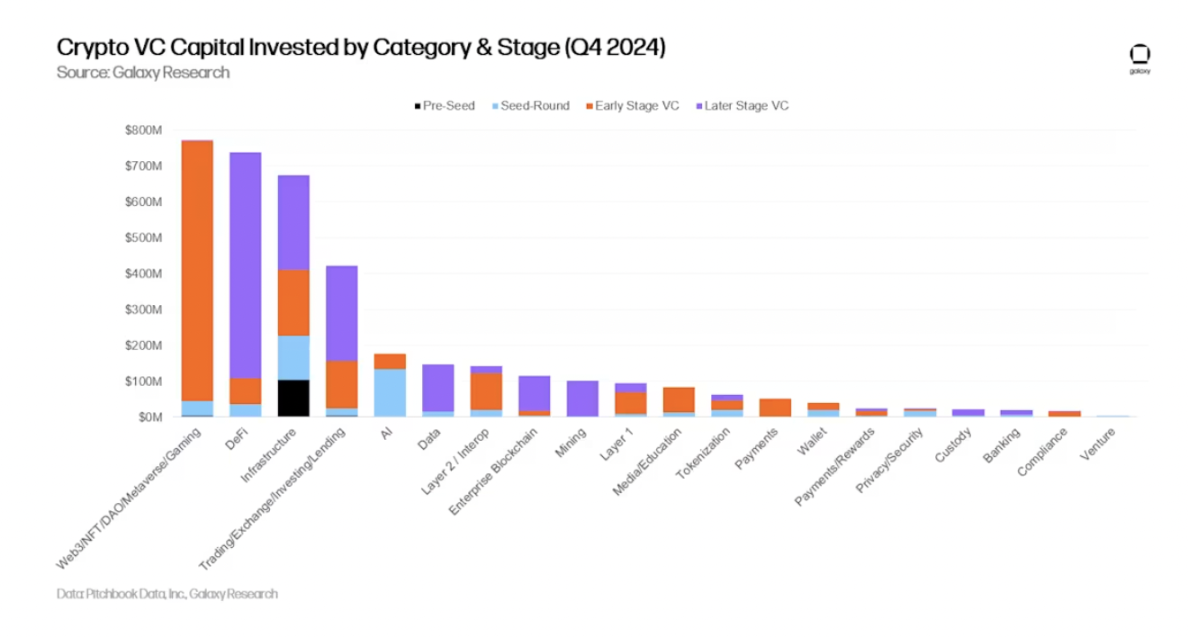
Analyzing the distribution of investment funds at different stages within each category reveals the relative maturity of various investment opportunities.
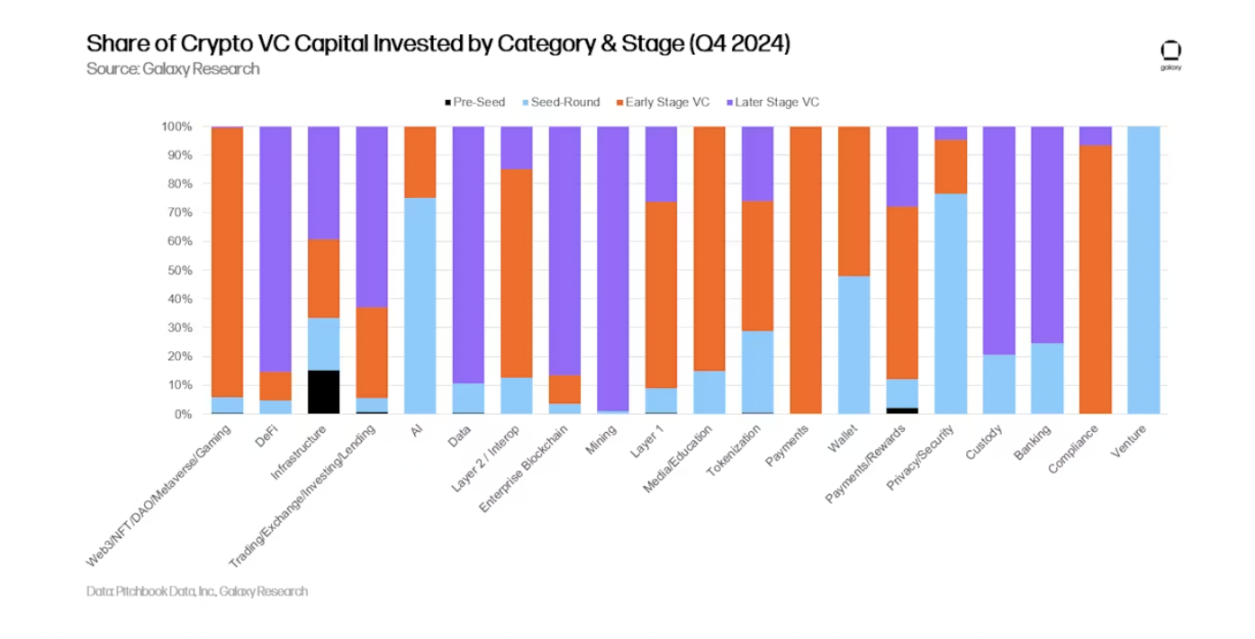
Similar to what happened with cryptocurrency venture capital in Q3 2024, a large portion of deals completed in Q4 2024 involved early-stage companies. Cryptocurrency venture capital deals tracked in Q4 2024 included 171 early-stage deals and 58 late-stage deals.
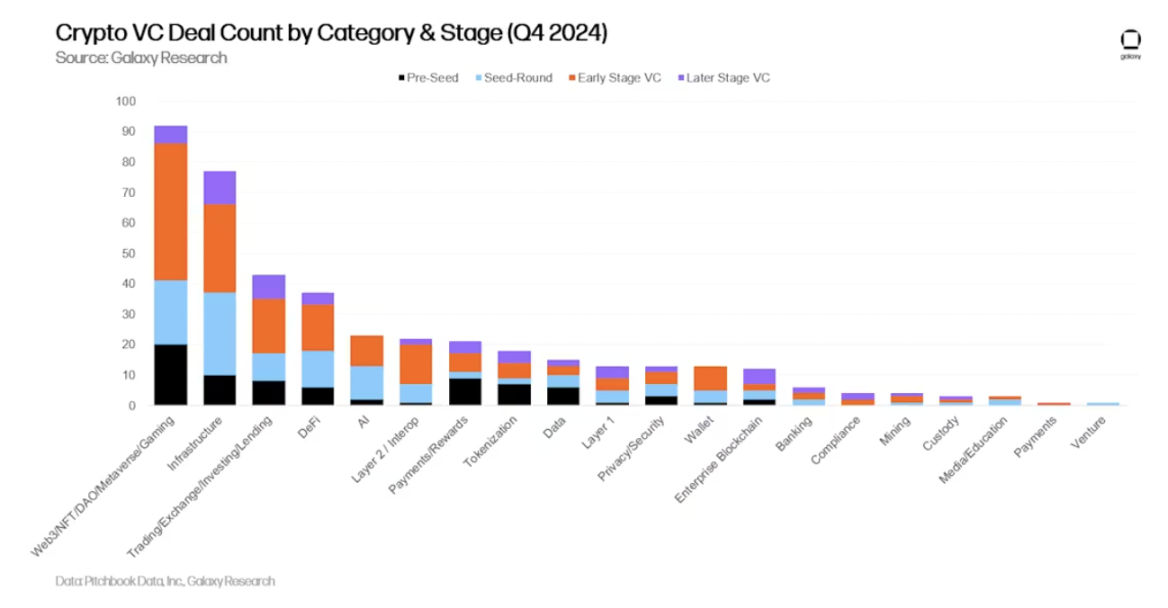
Studying the proportion of deals at each stage within each category can help understand the different stages of development of each investable category.
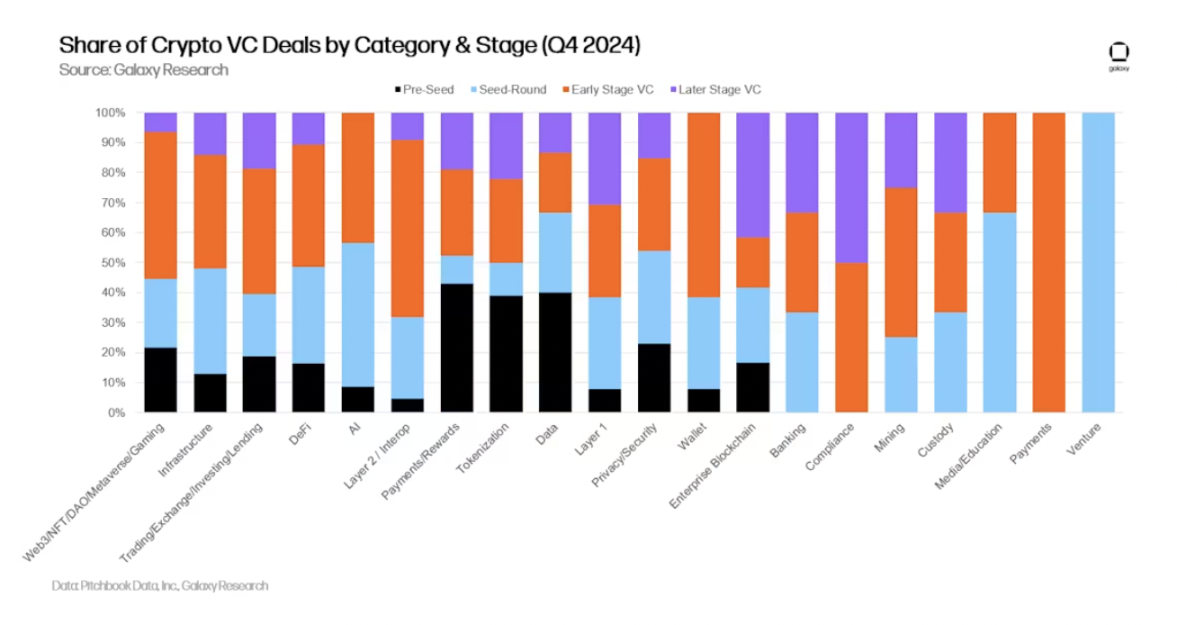
Investments by Geography
In the fourth quarter of 2024, 36.7% of transactions involved companies headquartered in the United States, with Singapore in second place at 9%, the United Kingdom at 8.1%, Switzerland at 5.5%, and the United Arab Emirates at 3.6%.
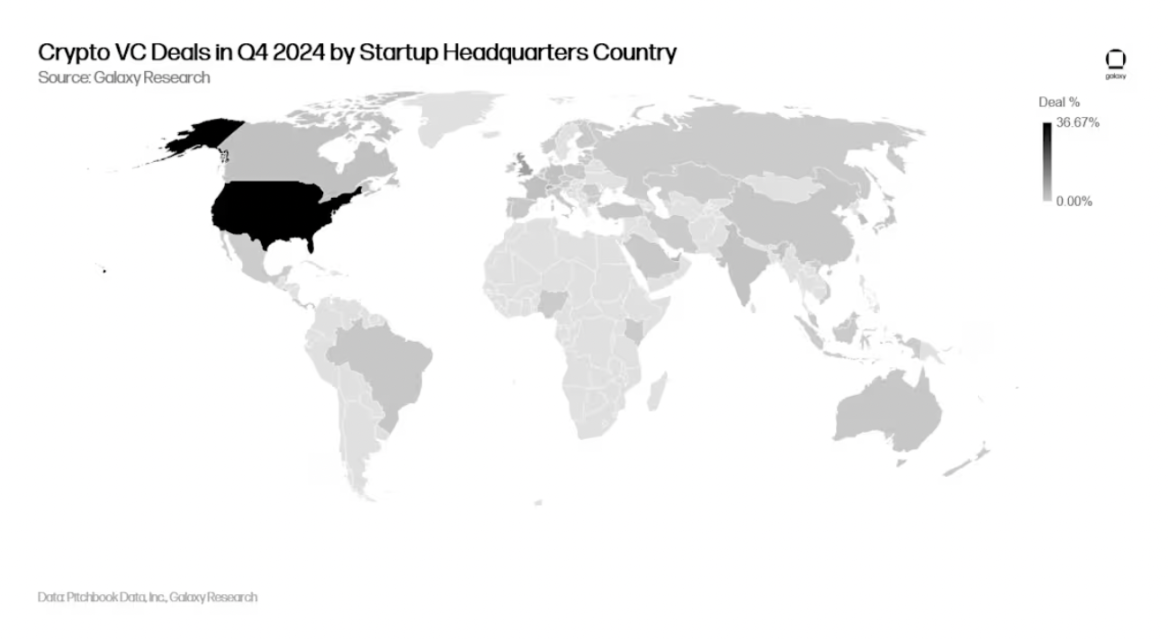
Companies headquartered in the United States received 46.2% of all venture capital investment, down 17 percentage points from the previous quarter. On the contrary, venture capital funding received by start-ups headquartered in Hong Kong increased significantly, accounting for 17.4%. The United Kingdom accounts for 6.8%, Canada accounts for 6%, and Singapore accounts for 5.4%.
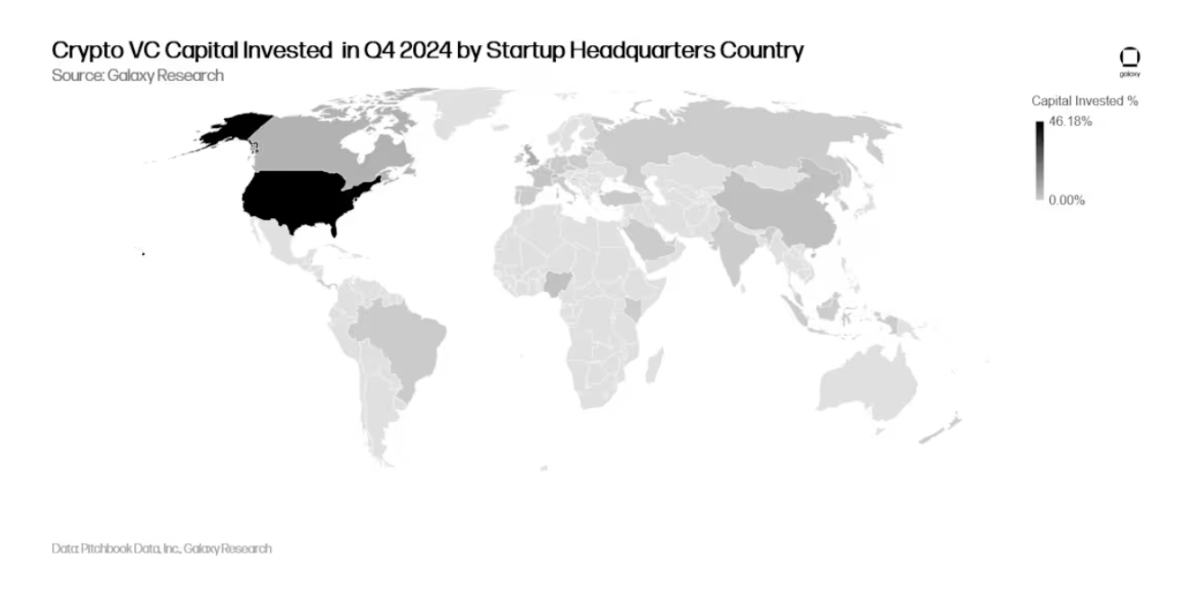
Investments by year of company establishment
Companies and projects founded in 2019 received the largest share of funding, while companies and projects founded in 2024 saw the largest number of deals.
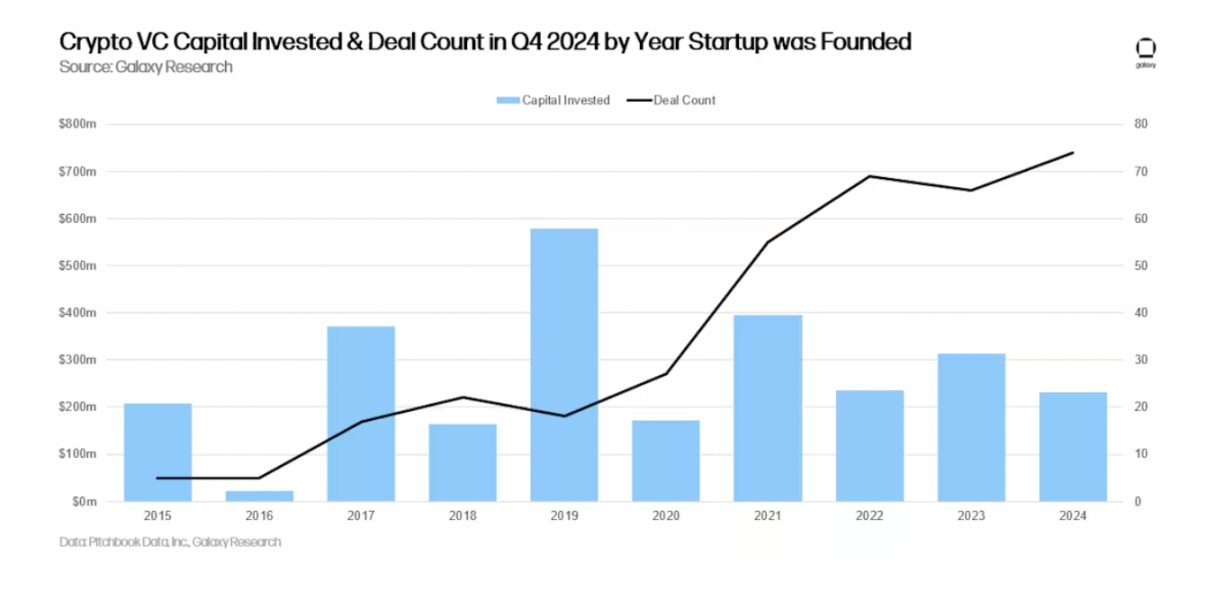
Venture capital fund fundraising status
Raising capital for cryptocurrency venture capital funds remains challenging. The macro environment in 2022 and 2023 and the turmoil in the cryptocurrency market have caused some capital allocators to no longer make the same scale commitments to cryptocurrency ventures as they did in 2021 and early 2022. At the beginning of 2024, investors generally believed that interest rates would fall significantly in 2024, although the rate cuts did not start to materialize until the second half of the year. Total funds allocated to venture capital funds have continued to decline sequentially since the third quarter of 2023, despite an increase in the number of new funds throughout 2024.
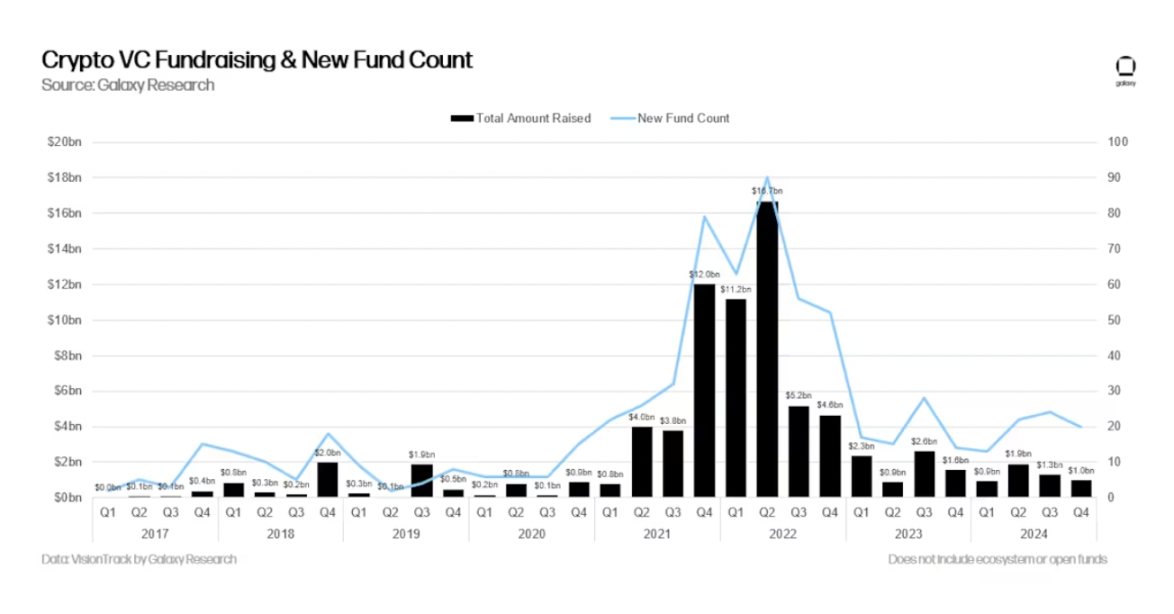
2024 was the weakest year for cryptocurrency venture capital fundraising since 2020, with 79 new funds raising a total of $5.1 billion, well below the frenetic levels of 2021-2022.
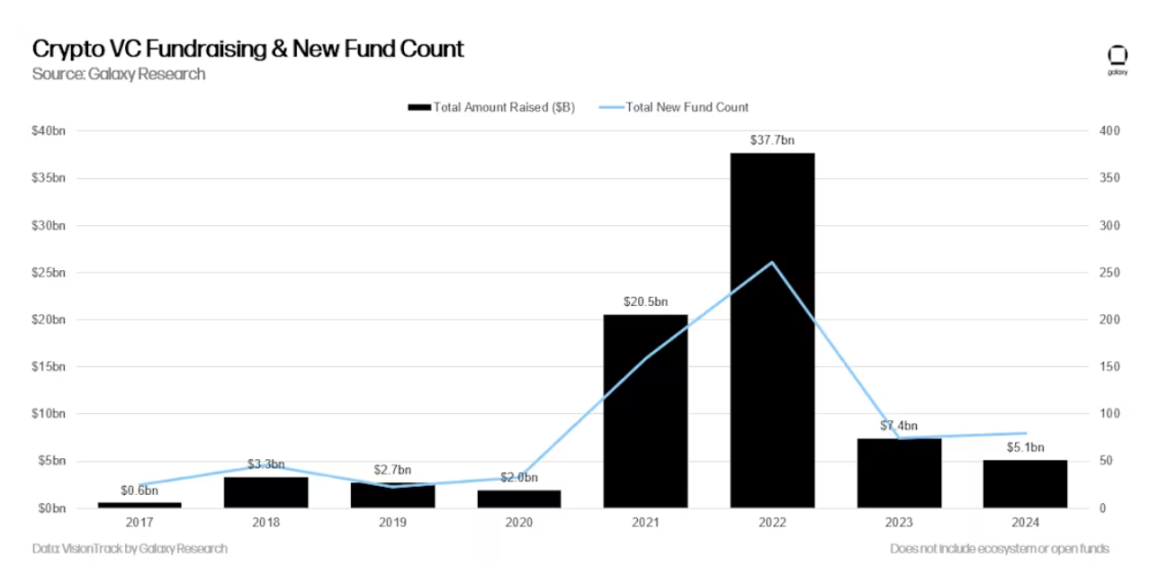
Although the number of new funds increased slightly year-on-year, the decline in capital allocator interest also led to smaller fund sizes raised by venture capital institutions, with the median and average fund size in 2024 falling to their lowest levels since 2017.
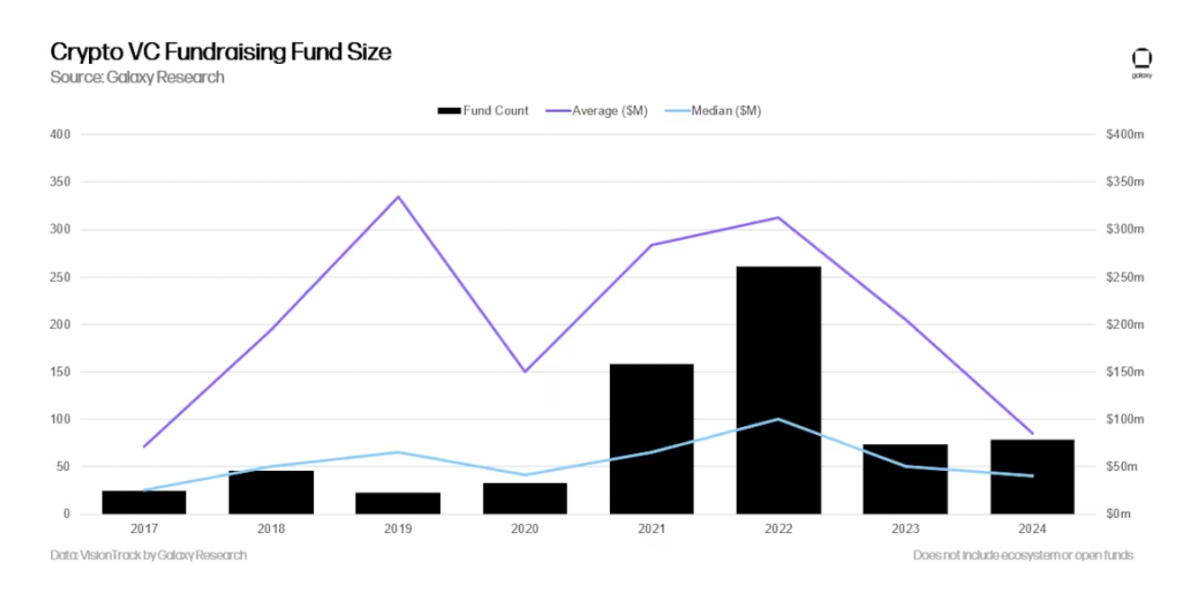
In 2024, at least 10 cryptocurrency venture capital funds actively investing in cryptocurrency and blockchain startups raised more than $100 million for new funds.
Summarize
- Market sentiment is improving and investment activity is picking up, but remains well below previous cycle highs. Although the crypto asset circulation market has recovered significantly from the end of 2022 to the beginning of 2023, venture capital activity is still far less than during the previous bull market. During the bull markets of 2017 and 2021, venture capital activity was closely correlated with crypto asset circulation prices, but over the past two years, venture capital activity has continued to be sluggish despite the recovery in cryptocurrency prices. The stagnation in venture capital investment is caused by a variety of factors, including the "barbell market", where Bitcoin takes center stage, and the new marginal net activity mainly comes from Memecoin, which is difficult to finance and has doubtful survival. Enthusiasm for projects at the intersection of artificial intelligence and cryptocurrencies is rising, and expected regulatory changes may bring opportunities in the areas of stablecoins, DeFi and asset tokenization.
- Early-stage investment deals still dominate. Despite the many hurdles venture capital faces, the focus on early-stage deals bodes well for the long-term health of the broader cryptocurrency ecosystem. Later-stage investment progressed in the fourth quarter, but this was mainly due to Cantor Fitzgerald's $600 million investment in Tether. Even so, entrepreneurs can still find investors willing to invest in innovative ideas. We believe that in 2025, projects and companies in stablecoins, artificial intelligence, DeFi, tokenization, Layer 2, and Bitcoin-related products are expected to perform well.
- Spot exchange-traded funds (ETPs) could put pressure on venture capital funds and startups. In the U.S., some capital allocators have made notable investments in spot Bitcoin ETFs, suggesting that some large investors (pensions, endowments, hedge funds, etc.) may be more inclined to invest in these large-scale , liquid vehicles to get involved in this field, rather than choosing early-stage venture capital. Interest in spot Ethereum ETFs is also starting to rise, and if this continues, or new ETFs are launched covering other Layer 1 blockchains, investments in areas like DeFi or Web3 Demand is likely going to these exchange-traded open-end index funds rather than the venture capital space.
- Fund managers still face a tough environment. While the number of new funds increased slightly year-over-year in 2024, the total capital allocated to cryptocurrency venture capital funds was slightly lower than in 2023. The macro environment continues to create headwinds for capital allocators, but significant changes in the regulatory environment could lead to renewed interest in the crypto space.
- The United States still dominates the cryptocurrency startup ecosystem. Despite a complex and often hostile regulatory regime, U.S.-based companies and projects still account for the majority of completed deals and the amount of investment received. The incoming presidential administration and Congress are expected to be the most crypto-friendly in U.S. history, and we expect U.S. dominance to grow even further, especially if certain regulatory matters fall into place as expected, such as stablecoin frameworks and markets Structural legislation that would allow traditional U.S. financial services companies to truly enter the crypto space.
